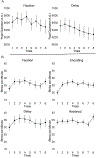Ocular measures during associative learning predict recall accuracy
- PMID: 34052234
- PMCID: PMC8286353
- DOI: 10.1016/j.ijpsycho.2021.05.010
Ocular measures during associative learning predict recall accuracy
Abstract
The ability to form associations between stimuli and commit those associations to memory is a cornerstone of human cognition. Dopamine and noradrenaline are critical neuromodulators implicated in a range of cognitive functions, including learning and memory. Eye blink rate (EBR) and pupil diameter have been shown to index dopaminergic and noradrenergic activity. Here, we examined how these ocular measures relate to accuracy in a paired-associate learning task where participants (N = 73) learned consistent object-location associations over eight trials consisting of pre-trial fixation, encoding, delay, and retrieval epochs. In order to examine how within-subject changes and between-subject changes in ocular metrics related to accuracy, we mean centered individual metric values on each trial based on within-person and across-subject means for each epoch. Within-participant variation in EBR was positively related to accuracy in both encoding and delay epochs: faster EBR within the individual predicted better retrieval. Differences in EBR across participants was negatively related to accuracy in the encoding epoch and in early trials of the pre-trial fixation: faster EBR, relative to other subjects, predicted poorer retrieval. Visual scanning behavior in pre-trial fixation and delay epochs was also positively related to accuracy in early trials: more scanning predicted better retrieval. We found no relationship between pupil diameter and accuracy. These results provide novel evidence supporting the utility of ocular metrics in illuminating cognitive and neurobiological mechanisms of paired-associate learning.
Keywords: Associative learning; Eye blink; Memory; Pupil.
Copyright © 2021 Elsevier B.V. All rights reserved.
Figures




Similar articles
-
How the size of the to-be-learned material influences the encoding and later retrieval of associative memories: A pupillometric assessment.PLoS One. 2019 Dec 31;14(12):e0226684. doi: 10.1371/journal.pone.0226684. eCollection 2019. PLoS One. 2019. PMID: 31891588 Free PMC article.
-
Individual differences in eye blink rate predict both transient and tonic pupil responses during reversal learning.PLoS One. 2017 Sep 29;12(9):e0185665. doi: 10.1371/journal.pone.0185665. eCollection 2017. PLoS One. 2017. PMID: 28961277 Free PMC article.
-
Using pupil dilation, eye-blink rate, and the value of mother to investigate reward learning mechanisms in infancy.Dev Cogn Neurosci. 2019 Apr;36:100608. doi: 10.1016/j.dcn.2018.12.006. Epub 2018 Dec 13. Dev Cogn Neurosci. 2019. PMID: 30581124 Free PMC article.
-
Spontaneous eye blink rate as predictor of dopamine-related cognitive function-A review.Neurosci Biobehav Rev. 2016 Dec;71:58-82. doi: 10.1016/j.neubiorev.2016.08.020. Epub 2016 Aug 21. Neurosci Biobehav Rev. 2016. PMID: 27555290 Review.
-
Own-age bias in face-name associations: Evidence from memory and visual attention in younger and older adults.Cognition. 2020 Jul;200:104253. doi: 10.1016/j.cognition.2020.104253. Epub 2020 Mar 17. Cognition. 2020. PMID: 32192981 Review.
Cited by
-
The importance of covert memory consolidation in schizophrenia: Dysfunctional network profiles of the hippocampus and the dorsolateral prefrontal cortex.Psychiatry Res Neuroimaging. 2024 Jun;340:111805. doi: 10.1016/j.pscychresns.2024.111805. Epub 2024 Feb 29. Psychiatry Res Neuroimaging. 2024. PMID: 38447230 Free PMC article.
-
Effects of DPTQ, a novel positive allosteric modulator of the dopamine D1 receptor, on spontaneous eye blink rate and spatial working memory in the nonhuman primate.Psychopharmacology (Berl). 2023 May;240(5):1033-1048. doi: 10.1007/s00213-022-06282-7. Epub 2023 Mar 24. Psychopharmacology (Berl). 2023. PMID: 36961560 Free PMC article.
References
Publication types
MeSH terms
Grants and funding
LinkOut - more resources
Full Text Sources
Other Literature Sources

